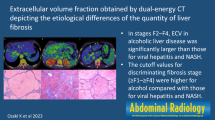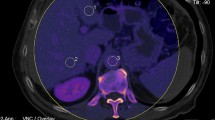Abstract
Purpose
To assess whether extracellular volume fraction (ECV) calculated from iodine(-blood) density images (I-B) of dual-energy liver CT (DECT) equilibrium phase data (EqD) is useful in estimating the degree of liver fibrosis.
Materials and methods
Consecutive 52 patients with chronic liver disease who underwent fast kV switching DECT and liver MR elastography (MRE) were retrospectively enrolled. Iodine(-water) density images (I-W) and I-B generated from EqD and ECV were calculated. As blood pools, abdominal aorta (Ao) and suprahepatic inferior vena cava (IVC) were chosen, and, therefore, 4 types of ECV (ECVI-W Ao, ECVI-W IVC, ECVI-B Ao, ECVI-B IVC) were obtained. ECV was also calculated using conventional method (ECVconv Ao). The correlation coefficients (R2 or rho) of these five ECVs versus liver stiffness (MRE) or pathologically proven fibrosis grades were compared.
Results
As for correlation with liver stiffness, R2 for ECVconv.Ao, ECVI-W Ao, ECVI-B Ao, ECVI-W IVC, and ECVI-B IVC, were 0.26, 0.34, 0.44, 0.39, and 0.52, respectively (all p < 0.0001). Histopathological correlation was available in 28 patients, and rho values were 0.61, 0.60, 0.71, 0.68, and 0.76, respectively (all p < 0.001).
Conclusion
ECVI–B IVC calculated from EqD of DECT is useful in estimating the degree of liver fibrosis.






Similar content being viewed by others
Abbreviations
- CT:
-
Computed tomography
- MR:
-
Magnetic resonance
- MRE:
-
Magnetic resonance elastography
- ECV:
-
Extracellular volume fraction
- ROI:
-
Region of interest
- DECT:
-
Dual-energy CT
- Ao:
-
Abdominal aorta
- IVC:
-
Inferior vena cava
- TR:
-
Repetition time
- TE:
-
Echo time
- SD:
-
Standard deviation
References
Martinez SM, Crespo G, Navasa M, Forns X. Noninvasive assessment of liver fibrosis. Hepatology. 2011;52:325–35.
Venkatesh SK, Yin M, Ehman RL. Magnetic resonance elastography of liver: technique, analysis, and clinical applications. J. Magn. Reson. Imaging. 2013;37:544–55.
Tang A, Cloutier G, Szevereny NM, Sirlin CB. Ultrasound elastography and MR elastography for assessing liver fibrosis: part 1, principles and techniques. AJR. 2015;205:22–32.
Tang A, Cloutier G, Szevereny NM, Sirlin CB. Ultrasound elastography and MR elastography for assessing liver fibrosis: Part 2, diagnostic performance, confounders, and future directions. AJR. 2015;205:33–40.
Yoshimitsu K, Mitsufuji T, Shinagawa Y, et al. MR elastography of the liver at 3.0 T in diagnosing liver fibrosis grades; preliminary clinical experience. Eur Radiol 2016;26(3):656–63.
Varenika VJ, Fu YJ, Maher JJ, et al. Hepatic fibrosis: evaluation with semiquantitative contrast-enhanced CT. Radiology. 2013;266:151–8.
Zissen MH, Wang ZJ, Yee J, Aslam R, Monto AM, Yeh BM. Contrast-enhanced CT quantification of the hepatic fractional extracellular space: correlation with diffuse liver disease severity. AJR. 2013;201:1204–10.
Bandula S, Punwani S, Rosenberg WM, et al. Equilibrium contrast-enhanced CT imaging to evaluate hepatic fibrosis: initial validation by comparison with histopathologic analysis. Radiology. 2015;275:136–43.
Yoon JH, Lee JM, Klotz E, et al. Estimation of hepatic extracellular volume fraction using multiphasic liver computed tomography for hepatic fibrosis grading. Invest Radiol. 2015;50:290–6.
Shinagawa Y, Sakamoto K, Sato K, et al. Usefulness of new subtraction algorithm in estimating degree of liver fibrosis by calculating extracellular volume fraction obtained from routine liver CT protocol equilibrium phase data: preliminary experience. EJR. 2018;103:99–104.
McCollough CH, Leng S, Yu L, et al. Dual-and multi-energy CT: principles, technical approaches, and clinical applications. Radiology. 2015;276:637–53.
Ep T, Le O, Liu X, et al. “How to” incorporate DE imaging into a high volume abdominal imaging practice. Abdom Radiol. 2017;42:688–701.
https://physics.nist.gov/PhysRefData/Xcom/html/xcom1.html. Accessed 30 Aug 2019.
Mitsufuji T, Shinagawa Y, Fujimitsu R, et al. Measurement repeatability of MR elastography at 3.0T: comparison among three different region-of-interest placement methods. Jpn J Radiol. 2013;31:336–41.
Shinagawa Y, Mitsufiji T, Morimoto S, et al. Optimization of scanning parameters for MR elastography at 3.0 T clinical unit: volunteer study. Jpn J Radiol. 2014;32:441–6.
The French METAVIR Cooperative Study Group. Intraobserver and interobserver variations in liver biopsy interpretation in patients with chronic hepatitis C. Hepatology. 1994;20:15–20.
Bedossa P. An algorithm for the grading of activity in chronic hepatitis C. Hepatology. 1996;24:289–93.
Foucher J, Chanteloup E, Vergniol J, et al. Diagnosis of cirrhosis by transient elastography (FibroScan): a prospective study. Gut. 2006;55:403–8.
Brunt EM. Grading and staging the histopathological lesions of chronic hepatitis: the Knodell histology activity index and beyond. Hepatology. 2000;31:241–6.
https://www.innervision.co.jp/suite/siemens/technote/080408/index.html. Accessed 30 Aug 2019.
Acknowledgements
We thank Professor Shotaro Sakisaka, Chair of the Department of Gastroenterology, Professor Suguru Hasegawa, Chair of the Department of Gastroenterological Surgery, and Professor Kazuki Nabeshima, Chair of the Department of Pathology, Faculty of Medicine, Fukuoka University, for providing clinical and pathological information.
Funding
This research received Grants-in-Aid for Scientific Research from the Japan Society for the Promotion of Science (Grant Number 16K10301). The funding source was used to purchase personal computers, software for analysis, other materials, etc., and also for travel expenses to attend scientific meetings to collect information or to present the data.
Author information
Authors and Affiliations
Contributions
KY is the guarantor of integrity of entire study, and was involved in the conception, statistical analysis, and manuscript editing. KS was involved in literature search, and clinical study. EI was involved in literature search, clinical study, and manuscript preparation. KS and RY were involved in literature search, statistical analysis, and manuscript preparation. HU was involved in literature search, and clinical study. All authors read and approved the final manuscript.
Corresponding author
Ethics declarations
Conflict of interest
None of the authors has conflict of interest to declare.
Ethics approval
Institutional approval was obtained and the need for consent waived.
Additional information
Publisher's Note
Springer Nature remains neutral with regard to jurisdictional claims in published maps and institutional affiliations.
About this article
Cite this article
Ito, E., Sato, K., Yamamoto, R. et al. Usefulness of iodine-blood material density images in estimating degree of liver fibrosis by calculating extracellular volume fraction obtained from routine dual-energy liver CT protocol equilibrium phase data: preliminary experience. Jpn J Radiol 38, 365–373 (2020). https://doi.org/10.1007/s11604-019-00918-z
Received:
Accepted:
Published:
Issue Date:
DOI: https://doi.org/10.1007/s11604-019-00918-z




